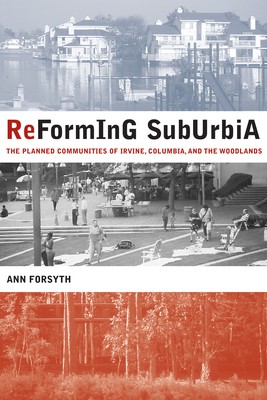
- We will send in 10–14 business days.
- Author: Ann Forsyth
- Publisher: University of California Press
- ISBN-10: 0520241665
- ISBN-13: 9780520241664
- Format: 15.5 x 23 x 2.6 cm, softcover
- Language: English
- SAVE -10% with code: EXTRA
Reviews
Description
The "new community" movement of the 1960s and 1970s attempted a grand experiment in housing. It inspired the construction of innovative communities that were designed to counter suburbia's cultural conformity, social isolation, ugliness, and environmental problems. This richly documented book examines the results of those experiments in three of the most successful new communities: Irvine Ranch in Southern California, Columbia in Maryland, and The Woodlands in the suburbs of Houston, Texas.
Based on new research and interviews with developers, designers, and residents, Ann Forsyth traces the evolution, the successes, and the shortcomings of these experiments in urban innovation. Where they succeeded, in areas such as community identity and open space preservation, they provide support for current "smart growth" proposals. Where they did not, in areas such as housing affordability and transportation choices, they offer important insights for today's planners, designers, developers, civic leaders, and others interested in incorporating new forms of development into their designs.
EXTRA 10 % discount with code: EXTRA
The promotion ends in 19d.02:34:56
The discount code is valid when purchasing from 10 €. Discounts do not stack.
- Author: Ann Forsyth
- Publisher: University of California Press
- ISBN-10: 0520241665
- ISBN-13: 9780520241664
- Format: 15.5 x 23 x 2.6 cm, softcover
- Language: English English
The "new community" movement of the 1960s and 1970s attempted a grand experiment in housing. It inspired the construction of innovative communities that were designed to counter suburbia's cultural conformity, social isolation, ugliness, and environmental problems. This richly documented book examines the results of those experiments in three of the most successful new communities: Irvine Ranch in Southern California, Columbia in Maryland, and The Woodlands in the suburbs of Houston, Texas.
Based on new research and interviews with developers, designers, and residents, Ann Forsyth traces the evolution, the successes, and the shortcomings of these experiments in urban innovation. Where they succeeded, in areas such as community identity and open space preservation, they provide support for current "smart growth" proposals. Where they did not, in areas such as housing affordability and transportation choices, they offer important insights for today's planners, designers, developers, civic leaders, and others interested in incorporating new forms of development into their designs.


Reviews